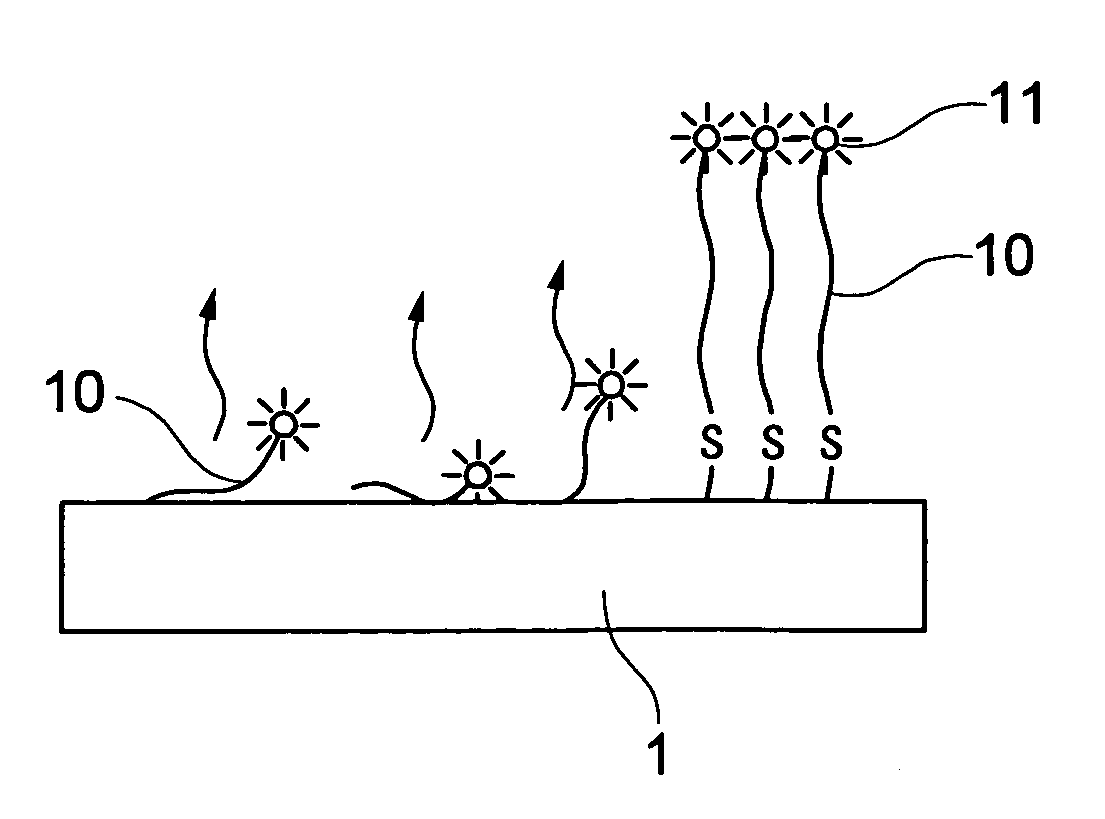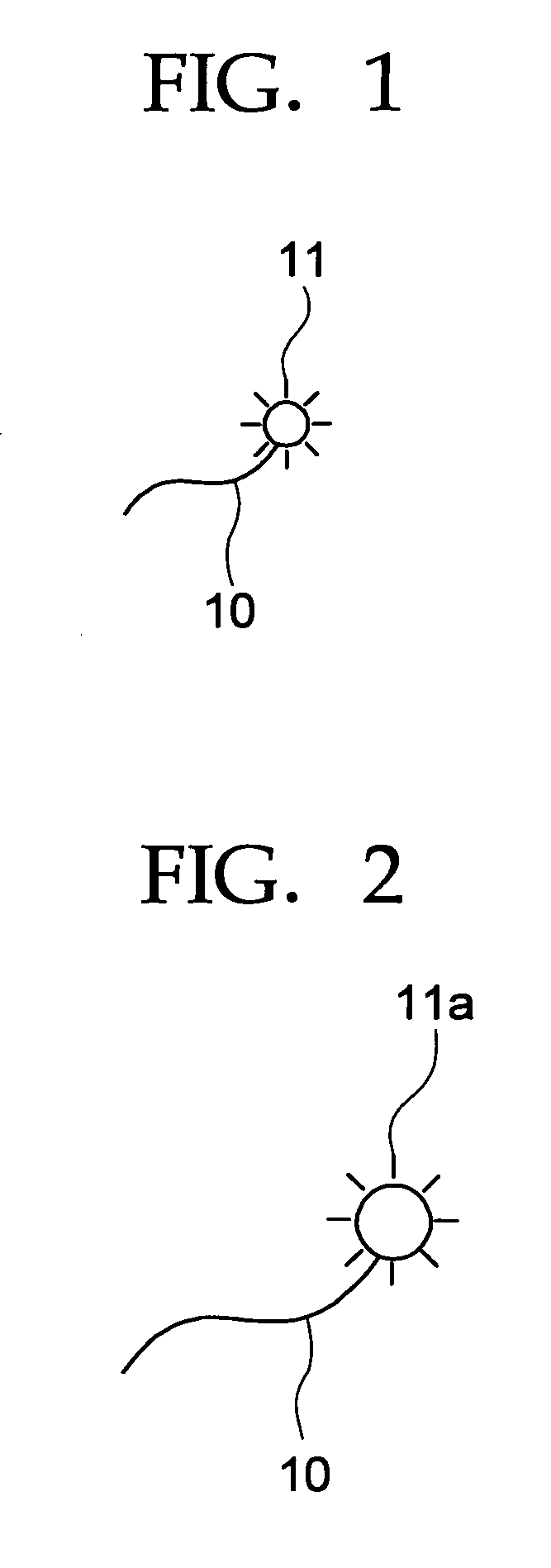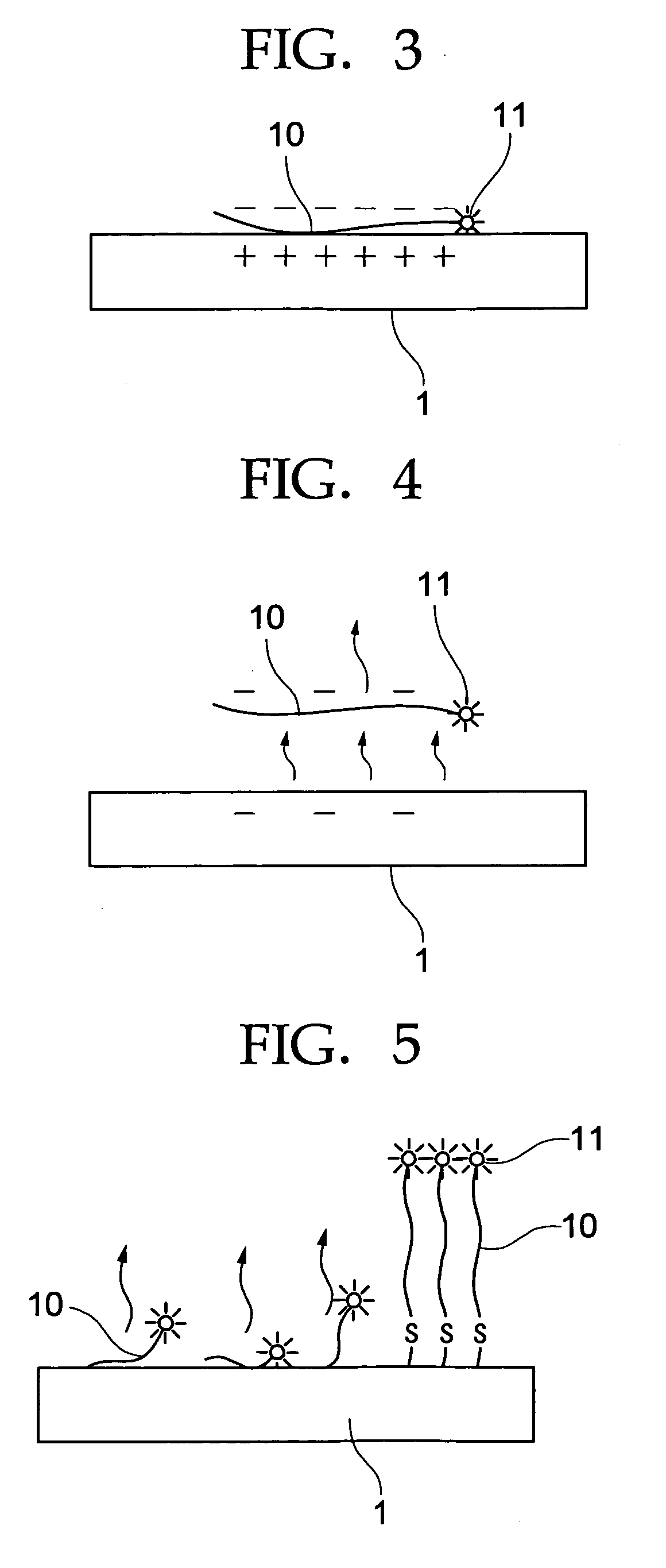Target detecting device and target capturer, device and method for molecular adsorption or desorption, and device and method for protein detection
a target detection and target technology, applied in the field of target detection devices and target capturers, and the use of specific bioreactors/fermenters, to achieve the effect of reducing the speed of molecular diffusion and achieving highly efficient analysis and/or diagnosis
- Summary
- Abstract
- Description
- Claims
- Application Information
AI Technical Summary
Benefits of technology
Problems solved by technology
Method used
Image
Examples
example 1
[0344] Initially, a single-stranded polynucleotide having twelve bases and containing (CH2)3 SS (CH2 )3OH at the three prime-end and the fluorescent dye represented by Structural Formula 1 and biotin at the five prime-end was synthetically prepared as the target capturer. In the target capturer, the fluorescent dye serves as the light emitting section, the biotin serves as the target capturing section, and the polynucleotide serves as the interacting section.
[0345] The target capturer was allowed to react with a polished circular metal electrode 1 (a gold electrode in this example) having a diameter of 7 mm at room temperature for 24 hours. The metal electrode 1 and a reference electrode facing the metal electrode 1 were placed in an electrolytic solution, a direct-current electric field was applied to between the two electrodes to thereby apply a positive electric field to the metal electrode 1 (gold electrode). Then, the single-stranded nucleotide serving as the interacting secti...
example 2
[0350] An example of the device or method for molecular adsorption or desorption or of the present invention is as mentioned above. A concrete test on the adsorption and desorption of the molecule in the working electrode will be illustrated below.
[0351] A gold electrode serving as the working electrode was formed on a quartz glass substrate as the substrate by vapor deposition. A dielectric film of silicon nitride was formed on the surface of the substrate and the gold electrode to expose part of the substrate and the gold electrode therefrom (FIGS. 10A and 10B). The gold electrode was evaluated by cyclic voltammetry, an electrochemical measuring process, and the result is shown in FIG. 22. The graph shows that the gold electrode has a low current at voltages from −0.7 V to 0.7 V, indicating that there is no significant oxidation-reduction reaction on the surface thereof, indicating that the gold electrode can be used without problems such as breakage in the application of a volta...
example 3
[0354] The device shown in FIGS. 24 and 25 was used herein.
[0355] Single-stranded oligonucleotides having a thiol group with the interposition of a spacer at the three prime-end were synthetically prepared by using a naturally-occurring single-stranded oligonucleotide and an artificial single-stranded oligonucleotide and were allowed to react with a polished gold electrode at room temperature for 24 hours reaction. Thus, the naturally-occurring single-stranded oligonucleotide and the artificial single-stranded oligonucleotide were allowed to bind with the gold electrode arranged on sapphire (FIG. 24). A fluorescent dye group had been introduced into the single-stranded oligonucleotides. The thiol group and the fluorescent dye group may be introduced at the end of the single stranded or at the five prime-end of the strand.
[0356] The oligonucleotide strands were immobilized to the circular gold electrode having a diameter of 1 mm. No quencher was used in the present example.
[0357] ...
PUM
| Property | Measurement | Unit |
|---|---|---|
| Electrical conductivity | aaaaa | aaaaa |
| Electric potential / voltage | aaaaa | aaaaa |
| Fluorescence | aaaaa | aaaaa |
Abstract
Description
Claims
Application Information
 Login to View More
Login to View More - R&D
- Intellectual Property
- Life Sciences
- Materials
- Tech Scout
- Unparalleled Data Quality
- Higher Quality Content
- 60% Fewer Hallucinations
Browse by: Latest US Patents, China's latest patents, Technical Efficacy Thesaurus, Application Domain, Technology Topic, Popular Technical Reports.
© 2025 PatSnap. All rights reserved.Legal|Privacy policy|Modern Slavery Act Transparency Statement|Sitemap|About US| Contact US: help@patsnap.com



